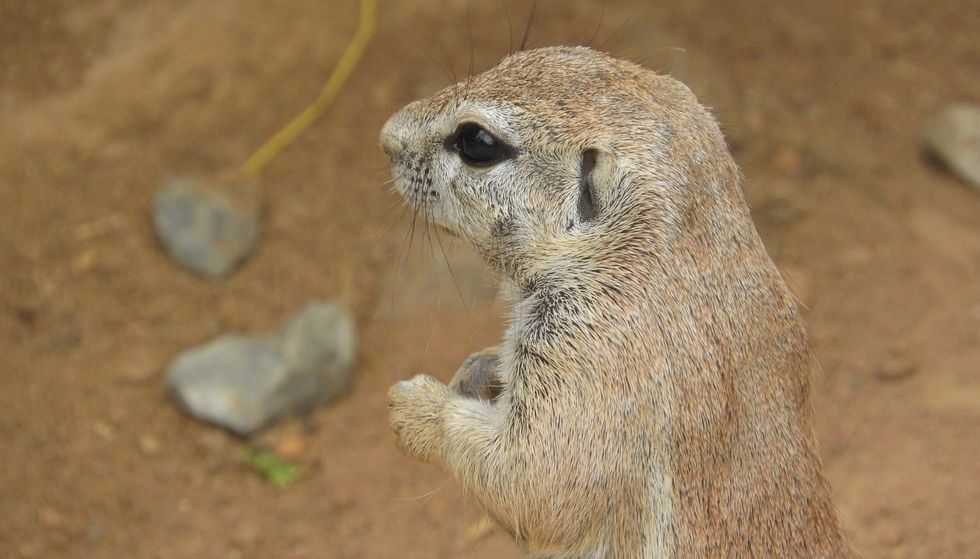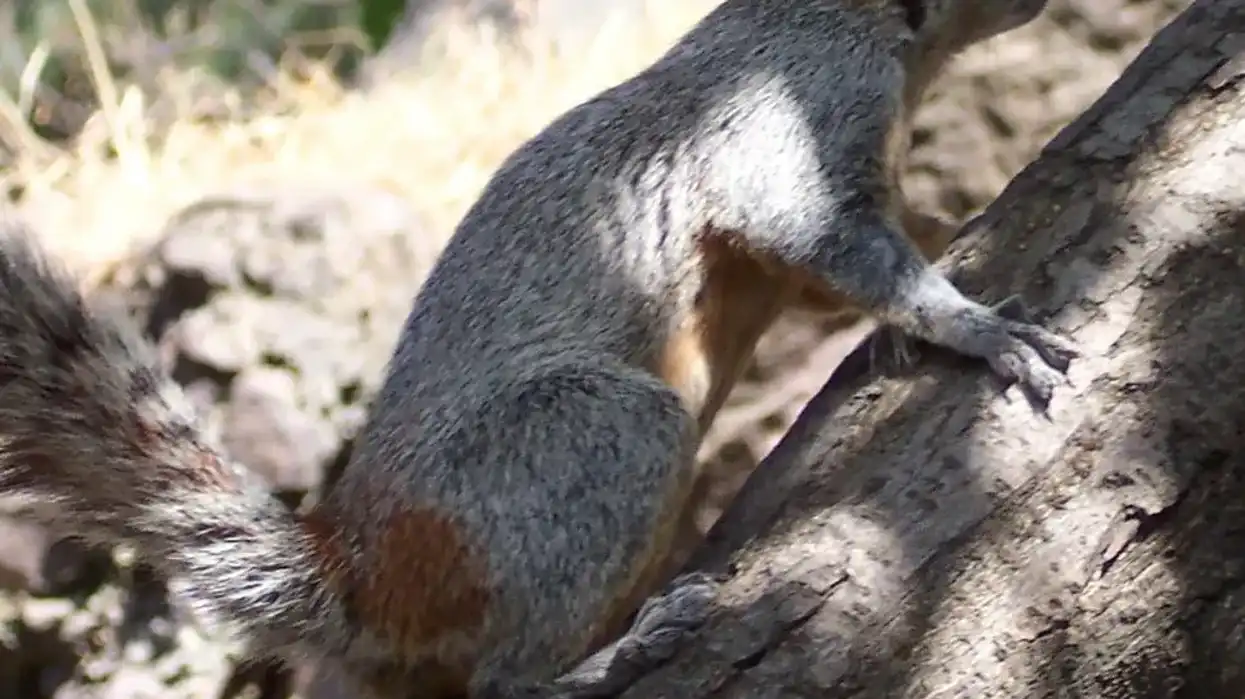Squirrels are some of the most fun animals to stare at as they busily go about their important business.
The group of squirrels in this articles is called the African ground squirrel in the genus Xerus consisting of four species which are the Cape ground squirrel or the South African ground squirrel (Xerus inauris), the unstriped ground squirrel (Xerus rutilus), the mountain ground squirrel (Xerus princess), and the striped ground squirrel (Xerus erythropus).
They are a part of the family Sciuridae, known to us as squirrels. All species in the genus have a Least Concern conservation status from the International Union for Conservation of Nature.
As the name of the genus suggests, they are all endemic to the African continent.
African ground squirrels (genus Xerus) all have a mostly brown or beige body with white undersides and white or black stripes, with unstriped ground squirrels being the only exception to this.
They are extremely sociable animals and live in groups of around three males and three females.
Mature male African ground squirrels can form their own groups of around 15-20 called bands. Unlike other species of squirrels, they are not territorial and do not fight over female mates, choosing the safety of overlapping habitats from predators over the increased breeding chances of territorialism.
The female gestation period lasts just under two months.
The four species of Xerus squirrels occupy a wide range of habitats all across the continent of Africa, with both the mountain ground squirrel and the cape or South African ground squirrel both being found in South Africa.
They all eat the same food, mostly grains, fruits, stalks, roots, and nuts, as well as small invertebrates, bird eggs, and insects.
They are diurnal, meaning they are most active during the day.
Their food habits have led to most farmers treating them as pests. There is quite a bit of size difference in these African squirrel species, with the smallest being striped ground squirrels, the smallest of which are just 8.7 in (21 cm) in length, while the South African ground squirrel (Xerus inauris) can grow to double that length.
The Cape ground squirrel's tail is as long as the body of a striped ground squirrel.
If you enjoy this article on African ground squirrels, make sure to check out our facts pages on the Indian palm squirrel and the Arctic ground squirrel.
African Ground Squirrel Interesting Facts
What type of animal is an African ground squirrel?
African ground squirrels (Xerus) are a type of squirrel that are found in a wide range of habitats in Africa.
What class of animal does an African ground squirrel belong to?
These ground squirrels are classified as Mammalia, meaning they are viviparous. They give birth to live young and nurture their young with milk produced by the female's mammary glands.
How many African ground squirrels are there in the world?
While the exact population size of the African ground squirrel (Xerus genus) is not known, considering all four species are of Least Concern, it can be safely assumed that they are abundantly found within their habitat range.
Where does an African ground squirrel live?
The African ground squirrel can be found in several African countries including but not limited to South Africa, the Central African Republic, Tanzania, Kenya, Morocco, Libya, and Congo.
What is an African ground squirrel's habitat?
African ground squirrels (Xerus) can be found in open grasslands, shrublands, woodlands, and rocky timberlands. They do not require the cover of trees that some other similar animals do since they can quickly dig a burrow in the ground to shelter themselves from predators and the elements of nature.
This ability of theirs is the root behind the common name, ground squirrel.
Who do African ground squirrels live with?
African ground squirrels are gregarious and live in groups of around 10 individuals, with half being male and half being female. A group of squirrels is known as a dray or a scurry. Alternatively, mature males may also form their own groups of 15-20 individuals which are called bands.
How long does an African ground squirrel live?
The average lifespan of a Xerus or African ground squirrel is around 10 years.
How do they reproduce?
Xerus squirrels or African ground squirrels reproduce sexually, just like every other species of squirrel. They have a gestation period of around 48 days and give birth to really cute Xerus squirrel babies that spend a lot of their first few months below ground.
What is their conservation status?
Every species in the genus Xerus of African ground squirrels is listed on the International Union for Conservation of Nature (IUCN) Red List of Threatened Species as a species of Least Concern. They are not endangered.
African Ground Squirrel Fun Facts
What do African ground squirrels look like?
Every species of African ground squirrel is light brown, beige, or tan in color. They all have white or lighter undersides and tail hairs and dorsal stripes of black or brown throughout their body.
The unstriped ground squirrel (Xerus rutilus) is the only major exception to this rule as it does not have any stripe throughout its body.
Their coloration is perfect for camouflaging in plain sight standing on the ground, and they can be really hard to spot even when standing up. Every species of Xerus or African ground squirrel has a tail almost as long as its body and small ears that often do not protrude from the skull at all.

How do they communicate?
African ground squirrels can communicate information to faraway squirrels by waving their tail like a flag. This is usually done as a warning call.
African ground squirrels also use chirps to express contentment or affection and barks to express aggression. The latter is not observed as often in African ground squirrels as in other species like the Indian giant squirrel and the giant flying squirrel since they are less aggressive by nature.
How big is an African ground squirrel?
The average size of all species of African ground squirrel is 13.7 in (35 cm), meaning they are almost exactly the same size as a Japanese squirrel and slightly smaller than the red-tailed squirrel.
How fast can an African ground squirrel move?
While the precise sprint speed of any of the Xerus squirrels has not been measured, similar species are known to be able to hit around 20 mph (32 kph).
How much does an African ground squirrel weigh?
There is a large amount of variation in the weight of different species of Xerus squirrels. However, the average of all these weights is around 1.4 lb (0.6 kg). When kept as pets, this weight makes them perfect for cuddling in your arms.
What are the male and female names of the species?
A male squirrel is called a boar, and a female is called a sow. A female African ground squirrel can be called an African ground sow, and a male is an African ground boar. The same goes for any specific species of the Xerus genus.
What would you call a baby African ground squirrel?
A baby squirrel is called a kit or kitten. A baby African ground squirrel can be referred to as an African ground kit or kitten. They're extremely cute and are born blind, spending most of their first couple months with their mother and underground.
What do they eat?
The food habits of African ground squirrels are just like any other. They enjoy eating grains, fruits, stalks, roots, and nuts, as well as small invertebrates, bird eggs, and insects. They can only be seen looking for food, socializing, and playing with their young during the day.
Are they dangerous?
No, they are far more likely to simply run away than attack. However, a cornered wild Xerus squirrel, or any other squirrel for that matter, will not hesitate to bite. These bites can be painful but should not cause any long-term problems provided the wound is treated for rabies and tetanus.
Would they make a good pet?
Yes, absolutely! They are gentle, docile, and can grow to love your companionship.
They are very intelligent and can be trained to do a variety of tricks using simple positive reinforcements. They're really cute and cuddly and look absolutely fantastic when curled up in a ball and sleeping. They are not good for yards though because they might uproot plants and kill shrubs.
Did you know...
Different species of African ground squirrels have actually been known to allow another species of the genus to enter their burrows. This may or may not be during times of distress such as when a predator is nearby or there's a sandstorm wreaking havoc.
It is not known for certain if the squirrel simply mistakes its guest as being from the same species as itself or if it knows its letting another species into its home.
Either way, this is an incredible sight to see in the wild. Imagine if us human routinely let other primates into our homes as guests!
What are the different types of African ground squirrels?
There are four different types of African ground squirrels. These are the South African ground squirrel or the Cape ground squirrel (Xerus inauris), the unstriped ground squirrel (Xerus rutilus), the mountain ground squirrel (Xerus princess), and the striped ground squirrel (Xerus erythropus). They share a lot of physical and behavioral similarities, but they also have differences.
The South African ground squirrel and the unstriped ground squirrel are the most sociable pair of the four species and live mostly in pairs. Female mountain ground squirrels live in small family groups, while the male of this species is mostly solitary.
They also do not demonstrate playing and allogrooming, a big difference compared to other species of the genus. Finally, the unstriped mountain squirrel is completely solitary and only interacts with other individuals in adulthood during mating.
In terms of physical appearance, differences between the species are mostly only in size and weight, with coloration largely being the same across all species. The unstriped ground squirrel does not have dorsal stripes like every one of its cousins.
What makes the African ground squirrel special?
They are intriguing due to their many social interactions with individuals of the same species as well as others. A lot of research and observation is yet to be made about them and their complex social hierarchies.
Here at Kidadl, we have carefully created lots of interesting family-friendly animal facts for everyone to discover! Learn more about some other mammals from our American marten facts and water rat facts pages.
You can even occupy yourself at home by coloring in one of our free printable squirrel coloring pages.









